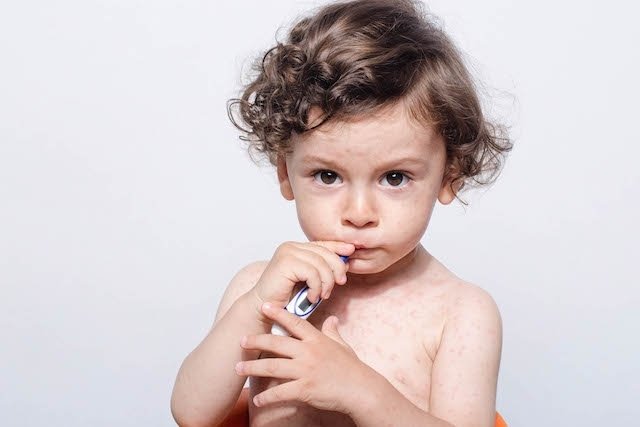Roseola is a disease caused by viruses, mainly human herpesvirus types 6 and 7, echovirus 16 and adenovirus, which can be transmitted through droplets of saliva.
Infantile roseola is an infectious disease that causes symptoms such as sudden high fever, decreased appetite and irritability, which last about 3 to 4 days, followed by the appearance of small pink spots on the child’s skin, mainly on the trunk, neck and arms, that may or may not itch.
It is important to consult your pediatrician if you suspect infantile roseola so that the diagnosis can be confirmed and treatment can be indicated, which can be done with medications to alleviate symptoms, such as antihistamine ointments to relieve itching or Paracetamol to control fever, for example.

Main symptoms
The main symptoms of infantile roseola are:
- High fever, between 38 and 40ºC, which lasts 3 to 4 days;
- Pink spots on the skin, which may or may not itch;
- Decreased appetite;
- Inflamed ganglia;
- Inflammation of the eyelids;
- Irritability;
- Cough;
- Runny nose;
- Redness of the throat;
- Diarrhea.
Roseola symptoms can last around 7 days and pink patches of skin can appear on the trunk, neck and arms that can last between 2 to 5 days and can disappear without peeling or changing the color of the skin.
How the diagnosis is made
To confirm the diagnosis of infantile roseola, it is very important to be evaluated by a pediatrician, who will evaluate the child’s symptoms and, if necessary, request tests that can confirm the disease, as there are several situations that cause fever and red spots on the child’s body. child. Learn about other causes of red spots on your baby’s skin.
Make an appointment with your nearest pediatrician to evaluate the possibility of infant roseola.
Taking care of your health has never been easier!
How transmission happens
Infant roseola is transmitted through contact with the saliva of another contaminated child, through speaking, kissing, coughing, sneezing or toys contaminated with saliva and can be transmitted even before the skin spots appear. Symptoms usually appear 5 to 15 days after infection, a period in which the viruses take hold and multiply.
This infection is not normally transmitted to adults because most people have defenses against roseola, even if they have never had the disease, but it is possible for an adult to contract roseola if their immune system is weakened. Furthermore, it is rare for pregnant women to become infected with the roseola virus and develop the disease during pregnancy, however, even if they acquire the infection, there are no complications for the fetus.
How the treatment is carried out
Infantile roseola has a benign evolution, as it usually heals naturally. Treatment is guided by the pediatrician, and consists of controlling the symptoms of the disease, and the use of Paracetamol or Dipyrone may be indicated to reduce fever and, thus, avoid febrile convulsions.
In addition to medicine, some measures that can help control fever are:
- Dress the child in light clothing;
- Avoid blankets and blankets, even if it is winter;
- Bathe the child only with water at a slightly warm temperature;
- Place a cloth soaked in fresh water on the child’s forehead for a few minutes and also on the armpits.
By following these guidelines, the fever should decrease a little without having to resort to medication, but it is necessary to check whether the child has a fever several times a day. While your child is sick, it is advised that they do not attend daycare or be in contact with other children.
Furthermore, another option to help complement the treatment and reduce fever is ash tea, as it has antipyretic, anti-inflammatory and healing properties, helping to alleviate the symptoms of roseola. However, it is important that ash tea is recommended by your pediatrician.
Bibliography
- STONE, R. C.; et al. Roseola infantum and its causal human herpesviruses. Int J Dermatol. 53. 4; 397-403, 2014
- MULLINS, T. B.; KRISHNAMURTHY, K. IN: STATPEARLS (INTERNET). TREASURE ISLAND (FL): STATPEARLS PUBLISHING. Infant Roseola. 2023. Available at: <https://www.ncbi.nlm.nih.gov/books/NBK448190/>. Accessed on 08 Nov 2023
- LEUNG, AKC; et al. Roseola Infantum: An Updated Review. Curr Pediatr Rev. 2022

Sign up for our newsletter and stay up to date with exclusive news
that can transform your routine!
Warning: Undefined array key "title" in /home/storelat/public_html/wp-content/plugins/link-whisper-premium/templates/frontend/related-posts.php on line 12
Warning: Undefined array key "title_tag" in /home/storelat/public_html/wp-content/plugins/link-whisper-premium/templates/frontend/related-posts.php on line 13




